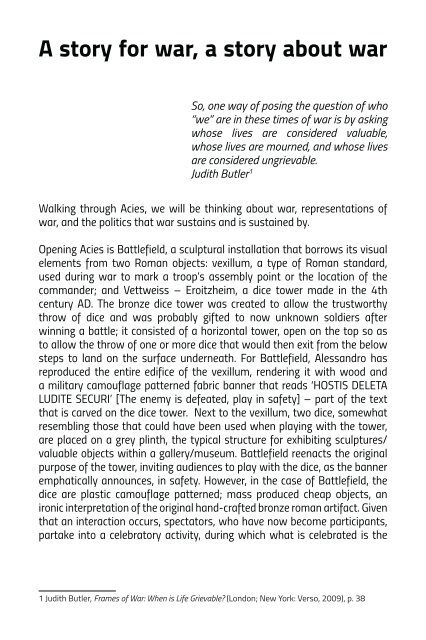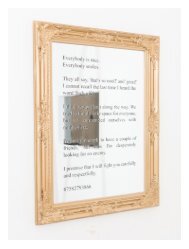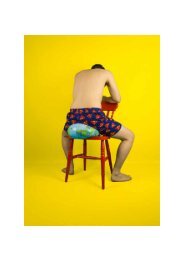Acies
This publication accompanies the exhibition “Acies” by Alessandro Di Massimo. It includes texts by Anastasia Philimonos and Alessandro Di Massimo and images of the show. A5, 18 pages, b/w, hand made cover made with sandpaper. First published by the artist for the exhibition “Acies”, 17 – 24 November 2017, The Number Shop, Edinburgh. All rights reserved.
This publication accompanies the exhibition “Acies” by Alessandro Di Massimo. It includes texts by Anastasia Philimonos and Alessandro Di Massimo and images of the show.
A5, 18 pages, b/w, hand made cover made with sandpaper.
First published by the artist for the exhibition “Acies”, 17 – 24 November 2017, The Number Shop, Edinburgh.
All rights reserved.
Create successful ePaper yourself
Turn your PDF publications into a flip-book with our unique Google optimized e-Paper software.
A story for war, a story about war<br />
So, one way of posing the question of who<br />
“we” are in these times of war is by asking<br />
whose lives are considered valuable,<br />
whose lives are mourned, and whose lives<br />
are considered ungrievable.<br />
Judith Butler 1<br />
Walking through <strong>Acies</strong>, we will be thinking about war, representations of<br />
war, and the politics that war sustains and is sustained by.<br />
Opening <strong>Acies</strong> is Battlefield, a sculptural installation that borrows its visual<br />
elements from two Roman objects: vexillum, a type of Roman standard,<br />
used during war to mark a troop’s assembly point or the location of the<br />
commander; and Vettweiss – Eroitzheim, a dice tower made in the 4th<br />
century AD. The bronze dice tower was created to allow the trustworthy<br />
throw of dice and was probably gifted to now unknown soldiers after<br />
winning a battle; it consisted of a horizontal tower, open on the top so as<br />
to allow the throw of one or more dice that would then exit from the below<br />
steps to land on the surface underneath. For Battlefield, Alessandro has<br />
reproduced the entire edifice of the vexillum, rendering it with wood and<br />
a military camouflage patterned fabric banner that reads ‘HOSTIS DELETA<br />
LUDITE SECURI’ [The enemy is defeated, play in safety] – part of the text<br />
that is carved on the dice tower. Next to the vexillum, two dice, somewhat<br />
resembling those that could have been used when playing with the tower,<br />
are placed on a grey plinth, the typical structure for exhibiting sculptures/<br />
valuable objects within a gallery/museum. Battlefield reenacts the original<br />
purpose of the tower, inviting audiences to play with the dice, as the banner<br />
emphatically announces, in safety. However, in the case of Battlefield, the<br />
dice are plastic camouflage patterned; mass produced cheap objects, an<br />
ironic interpretation of the original hand-crafted bronze roman artifact. Given<br />
that an interaction occurs, spectators, who have now become participants,<br />
partake into a celebratory activity, during which what is celebrated is the<br />
1 Judith Butler, Frames of War: When is Life Grievable? (London; New York: Verso, 2009), p. 38







